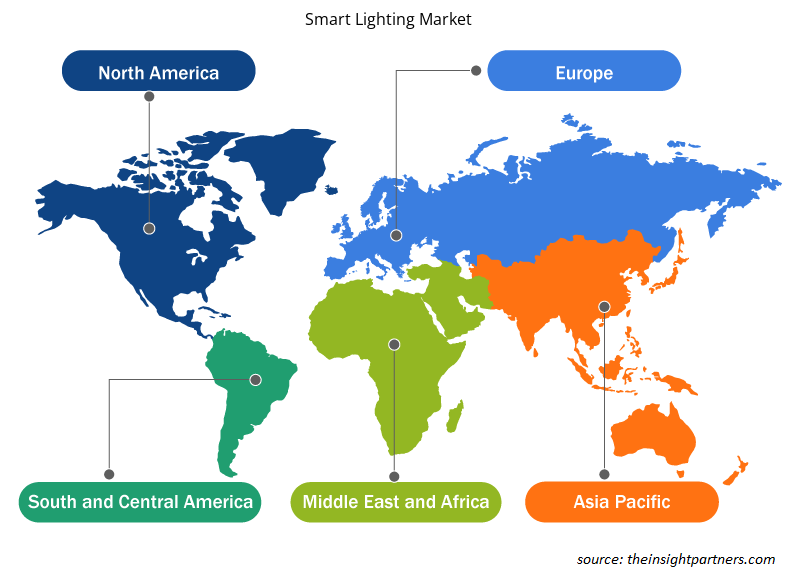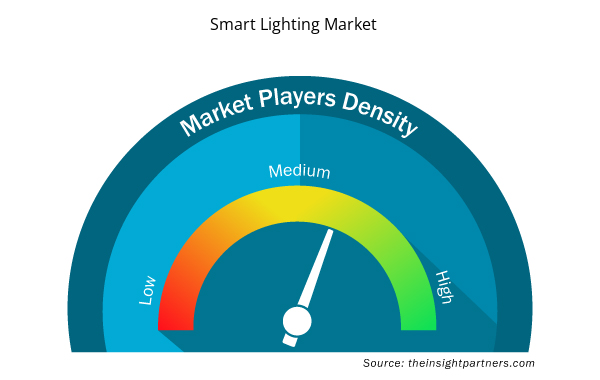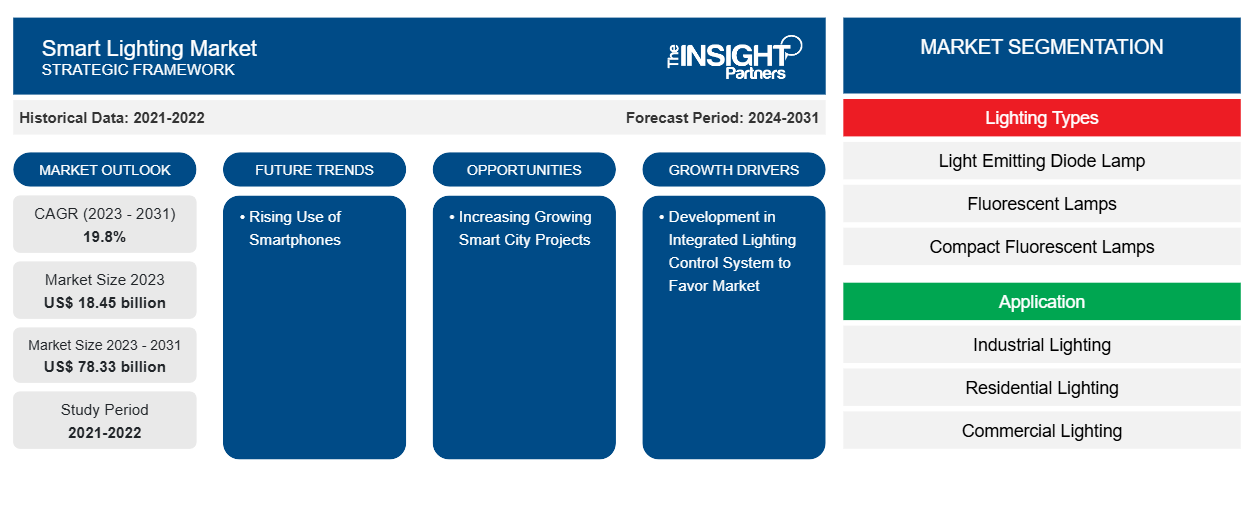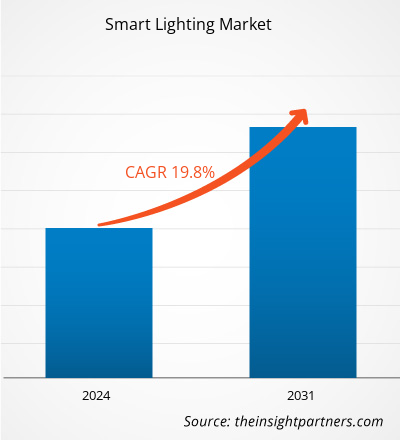Der Markt für intelligente Beleuchtung wird voraussichtlich von 18,45 Milliarden US-Dollar im Jahr 2023 auf 78,33 Milliarden US-Dollar im Jahr 2031 anwachsen. Der Markt wird voraussichtlich zwischen 2023 und 2031 eine durchschnittliche jährliche Wachstumsrate von 19,8 % verzeichnen. Die Entwicklung integrierter Lichtsteuerungssysteme und wachsende Smart-City-Projekte werden voraussichtlich weiterhin die wichtigsten Trends auf dem Markt für intelligente Beleuchtung bleiben.
Marktanalyse für intelligente Beleuchtung
Der Markt für intelligente Beleuchtung wächst rasant. In den letzten Jahren hat der Markt für intelligente Beleuchtung aufgrund der laufenden und bevorstehenden Smart-City-Projekte in Entwicklungsländern ein erhebliches Wachstum erfahren.
Marktübersicht für intelligente Beleuchtung
Leuchten sind sowohl in gewerblichen als auch in privaten Umgebungen beliebter und gefragter geworden, da sie sich mit IoT-Geräten verbinden lassen und mit einfachen Smartphones oder Tablets eine Reihe von Umgebungslicht erzeugen können. Bei Bedarf können intelligente Leuchten auf verschiedene Farbtöne gedimmt werden. Sie können auch über WLAN, Bluetooth, SmartThings, Z-Wave oder ZigBee verbunden und so programmiert werden, dass sie sich ein- oder ausschalten. Darüber hinaus kann die Sprachsteuerung von intelligenten Leuchten durch Plattformintegration wie Google Assistant, Microsoft Cortana, Apple Siri und Amazon Alexa erreicht werden. Neben der Beleuchtung umfassen diese umfangreichen Funktionssätze auch eine zunehmende Anzahl von IoT-Geräten und Smart-Assistant-Plattformen, die neue Wachstumschancen für den Markt für intelligente Beleuchtung eröffnet haben.
Passen Sie diesen Bericht Ihren Anforderungen an
Sie erhalten kostenlose Anpassungen an jedem Bericht, einschließlich Teilen dieses Berichts oder einer Analyse auf Länderebene, eines Excel-Datenpakets sowie tolle Angebote und Rabatte für Start-ups und Universitäten.
- Holen Sie sich die wichtigsten Markttrends aus diesem Bericht.Dieses KOSTENLOSE Beispiel umfasst eine Datenanalyse von Markttrends bis hin zu Schätzungen und Prognosen.
Treiber und Chancen auf dem Markt für intelligente Beleuchtung
Entwicklung eines integrierten Lichtsteuerungssystems begünstigt den Markt
Das Ein- und Ausschalten wird durch das integrierte Steuerungssystem von einem einzigen Standort aus ermöglicht. Die Kosteneffizienz intelligenter Beleuchtung und das gestiegene Bewusstsein der Verbraucher und der Regierung für die Notwendigkeit, Strom zu sparen, tragen zu ihrem wachsenden Marktanteil bei. Der Markt für intelligente Beleuchtung konnte aufgrund der Entwicklung integrierter Lichtsteuerungssysteme weltweit wachsen.
Zunehmendes Wachstum bei Smart City-Projekten
Da intelligente Beleuchtungsgeräte infolge laufender Smart-City-Projekte immer häufiger zum Einsatz kommen, wird erwartet, dass der weltweite Markt für intelligente Beleuchtung deutlich wachsen wird. Die Regierungen der Entwicklungsländer investieren massiv in die Schaffung intelligenter Städte. Für zahlreiche Anbieter in den Bereichen Beratung, Versorgungsleistungen und Informationstechnologie bietet dies eine erhebliche Geschäftschance. Da die optimale Nutzung des verfügbaren Stroms eines der Hauptziele der Entwicklung intelligenter Städte ist und intelligente Beleuchtung aufgrund ihrer Effizienz immer beliebter wird, passt intelligente Beleuchtung zu Smart-City-Projekten. Es wird prognostiziert, dass die Implementierung intelligenter Beleuchtung erheblich zu Energieeinsparungen und Nachhaltigkeit beitragen wird.
Segmentierungsanalyse des Marktberichts für intelligente Beleuchtung
Wichtige Segmente, die zur Ableitung der Marktanalyse für intelligente Beleuchtung beigetragen haben, sind Beleuchtungsarten, Anwendungen und Konnektivitätstechnologie.
- Basierend auf Beleuchtungsarten ist der Markt für intelligente Beleuchtung in Leuchtdiodenlampen (LED), Leuchtstofflampen, Kompaktleuchtstofflampen (CFL), Hochdruckentladungslampen und andere (Neonlampen und Fotoblitze) unterteilt. Das LED-Segment hatte im Jahr 2023 einen größeren Marktanteil.CFL), high-intensity discharge lamps, and others (neon lamps and photographic flashes). The LED segment held a larger market share in 2023.
- Nach Anwendungsgröße ist der Markt in Industriebeleuchtung, Wohnbeleuchtung, Gewerbebeleuchtung, Regierungsbeleuchtung, Außenbeleuchtung und Automobilbeleuchtung segmentiert . Das Wohnsegment hatte im Jahr 2023 den größten Marktanteil.
- Basierend auf der Konnektivitätstechnologie ist der Markt für intelligente Beleuchtung in kabelgebundene und kabellose unterteilt. Das kabellose Segment hatte im Jahr 2023 einen größeren Marktanteil.
Marktanteilsanalyse für intelligente Beleuchtung nach geografischer Lage
Der geografische Umfang des Smart Lighting-Marktberichts ist hauptsächlich in fünf Regionen unterteilt: Nordamerika, Asien-Pazifik, Europa, Naher Osten und Afrika sowie Südamerika/Süd- und Mittelamerika. Nordamerika hat den Smart Lighting-Markt dominiert. Trends zur Einführung hoher Technologien in verschiedenen Branchen der Region haben das Wachstum des Smart Lighting-Marktes vorangetrieben. Faktoren wie die zunehmende Einführung digitaler Tools und hohe Technologieausgaben von Regierungsbehörden dürften das Wachstum des nordamerikanischen Smart Lighting-Marktes vorantreiben. Darüber hinaus zwingt eine starke Betonung von Forschung und Entwicklung in den entwickelten Volkswirtschaften nordamerikanische Akteure dazu, technologisch fortschrittliche Lösungen auf den Markt zu bringen. All diese Faktoren tragen zum Wachstum des Smart Lighting-Marktes in der Region bei.
Regionale Einblicke in den Markt für intelligente Beleuchtung
Die regionalen Trends und Faktoren, die den Smart Lighting-Markt im Prognosezeitraum beeinflussen, wurden von den Analysten von Insight Partners ausführlich erläutert. In diesem Abschnitt werden auch die Marktsegmente und die Geografie des Smart Lighting-Marktes in Nordamerika, Europa, im asiatisch-pazifischen Raum, im Nahen Osten und Afrika sowie in Süd- und Mittelamerika erörtert.

- Erhalten Sie regionale Daten zum Markt für intelligente Beleuchtung
Umfang des Marktberichts für intelligente Beleuchtung
| Berichtsattribut | Details |
|---|---|
| Marktgröße im Jahr 2023 | 18,45 Milliarden US-Dollar |
| Marktgröße bis 2031 | 78,33 Milliarden US-Dollar |
| Globale CAGR (2023 - 2031) | 19,8 % |
| Historische Daten | 2021-2022 |
| Prognosezeitraum | 2024–2031 |
| Abgedeckte Segmente | Nach Beleuchtungsarten
|
| Abgedeckte Regionen und Länder | Nordamerika
|
| Marktführer und wichtige Unternehmensprofile |
|
Dichte der Marktteilnehmer für intelligente Beleuchtung: Die Auswirkungen auf die Geschäftsdynamik verstehen
Der Markt für intelligente Beleuchtung wächst rasant. Dies wird durch die steigende Nachfrage der Endnutzer aufgrund von Faktoren wie sich entwickelnden Verbraucherpräferenzen, technologischen Fortschritten und einem größeren Bewusstsein für die Vorteile des Produkts vorangetrieben. Mit der steigenden Nachfrage erweitern Unternehmen ihr Angebot, entwickeln Innovationen, um die Bedürfnisse der Verbraucher zu erfüllen, und nutzen neue Trends, was das Marktwachstum weiter ankurbelt.
Die Marktteilnehmerdichte bezieht sich auf die Verteilung von Firmen oder Unternehmen, die in einem bestimmten Markt oder einer bestimmten Branche tätig sind. Sie gibt an, wie viele Wettbewerber (Marktteilnehmer) in einem bestimmten Marktraum im Verhältnis zu seiner Größe oder seinem gesamten Marktwert präsent sind.
Die wichtigsten auf dem Markt für intelligente Beleuchtung tätigen Unternehmen sind:
- Signify Holding
- Legrand North America, LLC
- Gesellschaften, beginnend mit ACUITY
- Lutron Electronics Co., Inc
- Leviton Manufacturing Co., Inc
- Zumtobel
Haftungsausschluss : Die oben aufgeführten Unternehmen sind nicht in einer bestimmten Reihenfolge aufgeführt.

- Überblick über die wichtigsten Akteure auf dem Markt für intelligente Beleuchtung
Neuigkeiten und aktuelle Entwicklungen zum Markt für intelligente Beleuchtung
Der Markt für intelligente Beleuchtung wird durch die Erfassung qualitativer und quantitativer Daten nach Primär- und Sekundärforschung bewertet, die wichtige Unternehmensveröffentlichungen, Verbandsdaten und Datenbanken umfasst. Im Folgenden finden Sie eine Liste der Entwicklungen auf dem Markt:
- Im Februar 2023 lieferte Signify, einer der weltweit führenden Anbieter von Beleuchtungslösungen, LED-Straßenbeleuchtung, intelligente Masten und ein vernetztes Beleuchtungssystem an die Industrieparks in der Stadt Huanggang in der chinesischen Provinz Hubei. Dieses groß angelegte Smart-Pole-Projekt wird es der Provinz ermöglichen, Energiekosten und Emissionen zu sparen und gleichzeitig die städtische Infrastruktur zu digitalisieren.
(Quelle: Signify, Pressemitteilung, 2023)
- Um eine bessere nahtlose Verknüpfung mit der Smart-IoT-Plattform zu ermöglichen und den Benutzern eine bequemere intelligente Interaktion zu bieten, hat Yeelight als führender Lösungsanbieter im Bereich intelligente Beleuchtung im November 2023 offiziell eine aktualisierte Lösung auf Basis der nahtlosen Einrichtung des BLE Mesh-Protokolls für Hersteller und Marken eingeführt.
(Quelle: Yeelight, Pressemitteilung, 2023)
Marktbericht zu intelligenter Beleuchtung – Abdeckung und Ergebnisse
Der Bericht „Marktgröße und Prognose für intelligente Beleuchtung (2021–2031)“ bietet eine detaillierte Analyse des Marktes, die die folgenden Bereiche abdeckt:
- Marktgröße und Prognose auf globaler, regionaler und Länderebene für alle abgedeckten wichtigen Marktsegmente.
- Marktdynamik wie Treiber, Beschränkungen und wichtige Chancen
- Wichtige Zukunftstrends
- Detaillierte PEST/Porters Five Forces- und SWOT-Analyse
- Globale und regionale Marktanalyse, die wichtige Markttrends, wichtige Akteure, Vorschriften und aktuelle Marktentwicklungen abdeckt.
- Branchenlandschaft und Wettbewerbsanalyse, einschließlich Marktkonzentration, Heatmap-Analyse, prominenten Akteuren und aktuellen Entwicklungen.
- Detaillierte Firmenprofile
- Historische Analyse (2 Jahre), Basisjahr, Prognose (7 Jahre) mit CAGR
- PEST- und SWOT-Analyse
- Marktgröße Wert/Volumen – Global, Regional, Land
- Branche und Wettbewerbsumfeld
- Excel-Datensatz



Report Coverage
Revenue forecast, Company Analysis, Industry landscape, Growth factors, and Trends

Segment Covered
This text is related
to segments covered.

Regional Scope
North America, Europe, Asia Pacific, Middle East & Africa, South & Central America

Country Scope
This text is related
to country scope.
Häufig gestellte Fragen
The development of smart cities is anticipated to play a significant role in the global smart lighting market in the coming years.
The global smart lighting market was estimated to be US$ 18.45 billion in 2023 and is expected to grow at a CAGR of 19.8% during the forecast period 2024 - 2031.
Development in integrated lighting control systems is the major factor that propels the global smart lighting market.
The global smart lighting market is expected to reach US$ 78.33 billion by 2031.
The key players holding majority shares in the global smart lighting market are Signify Holding, Legrand North America, LLC, ACUITY BRANDS, INC., Lutron Electronics Co., Inc., Leviton Manufacturing Co., Inc, Zumtobel, Honeywell, SAVANT TECHNOLOGIES LLC, Dialight, Panasonic.
Trends and growth analysis reports related to Electronics and Semiconductor : READ MORE..
The Insight Partners performs research in 4 major stages: Data Collection & Secondary Research, Primary Research, Data Analysis and Data Triangulation & Final Review.
- Data Collection and Secondary Research:
As a market research and consulting firm operating from a decade, we have published and advised several client across the globe. First step for any study will start with an assessment of currently available data and insights from existing reports. Further, historical and current market information is collected from Investor Presentations, Annual Reports, SEC Filings, etc., and other information related to company’s performance and market positioning are gathered from Paid Databases (Factiva, Hoovers, and Reuters) and various other publications available in public domain.
Several associations trade associates, technical forums, institutes, societies and organization are accessed to gain technical as well as market related insights through their publications such as research papers, blogs and press releases related to the studies are referred to get cues about the market. Further, white papers, journals, magazines, and other news articles published in last 3 years are scrutinized and analyzed to understand the current market trends.
- Primary Research:
The primarily interview analysis comprise of data obtained from industry participants interview and answers to survey questions gathered by in-house primary team.
For primary research, interviews are conducted with industry experts/CEOs/Marketing Managers/VPs/Subject Matter Experts from both demand and supply side to get a 360-degree view of the market. The primary team conducts several interviews based on the complexity of the markets to understand the various market trends and dynamics which makes research more credible and precise.
A typical research interview fulfils the following functions:
- Provides first-hand information on the market size, market trends, growth trends, competitive landscape, and outlook
- Validates and strengthens in-house secondary research findings
- Develops the analysis team’s expertise and market understanding
Primary research involves email interactions and telephone interviews for each market, category, segment, and sub-segment across geographies. The participants who typically take part in such a process include, but are not limited to:
- Industry participants: VPs, business development managers, market intelligence managers and national sales managers
- Outside experts: Valuation experts, research analysts and key opinion leaders specializing in the electronics and semiconductor industry.
Below is the breakup of our primary respondents by company, designation, and region:

Once we receive the confirmation from primary research sources or primary respondents, we finalize the base year market estimation and forecast the data as per the macroeconomic and microeconomic factors assessed during data collection.
- Data Analysis:
Once data is validated through both secondary as well as primary respondents, we finalize the market estimations by hypothesis formulation and factor analysis at regional and country level.
- Macro-Economic Factor Analysis:
We analyse macroeconomic indicators such the gross domestic product (GDP), increase in the demand for goods and services across industries, technological advancement, regional economic growth, governmental policies, the influence of COVID-19, PEST analysis, and other aspects. This analysis aids in setting benchmarks for various nations/regions and approximating market splits. Additionally, the general trend of the aforementioned components aid in determining the market's development possibilities.
- Country Level Data:
Various factors that are especially aligned to the country are taken into account to determine the market size for a certain area and country, including the presence of vendors, such as headquarters and offices, the country's GDP, demand patterns, and industry growth. To comprehend the market dynamics for the nation, a number of growth variables, inhibitors, application areas, and current market trends are researched. The aforementioned elements aid in determining the country's overall market's growth potential.
- Company Profile:
The “Table of Contents” is formulated by listing and analyzing more than 25 - 30 companies operating in the market ecosystem across geographies. However, we profile only 10 companies as a standard practice in our syndicate reports. These 10 companies comprise leading, emerging, and regional players. Nonetheless, our analysis is not restricted to the 10 listed companies, we also analyze other companies present in the market to develop a holistic view and understand the prevailing trends. The “Company Profiles” section in the report covers key facts, business description, products & services, financial information, SWOT analysis, and key developments. The financial information presented is extracted from the annual reports and official documents of the publicly listed companies. Upon collecting the information for the sections of respective companies, we verify them via various primary sources and then compile the data in respective company profiles. The company level information helps us in deriving the base number as well as in forecasting the market size.
- Developing Base Number:
Aggregation of sales statistics (2020-2022) and macro-economic factor, and other secondary and primary research insights are utilized to arrive at base number and related market shares for 2022. The data gaps are identified in this step and relevant market data is analyzed, collected from paid primary interviews or databases. On finalizing the base year market size, forecasts are developed on the basis of macro-economic, industry and market growth factors and company level analysis.
- Data Triangulation and Final Review:
The market findings and base year market size calculations are validated from supply as well as demand side. Demand side validations are based on macro-economic factor analysis and benchmarks for respective regions and countries. In case of supply side validations, revenues of major companies are estimated (in case not available) based on industry benchmark, approximate number of employees, product portfolio, and primary interviews revenues are gathered. Further revenue from target product/service segment is assessed to avoid overshooting of market statistics. In case of heavy deviations between supply and demand side values, all thes steps are repeated to achieve synchronization.
We follow an iterative model, wherein we share our research findings with Subject Matter Experts (SME’s) and Key Opinion Leaders (KOLs) until consensus view of the market is not formulated – this model negates any drastic deviation in the opinions of experts. Only validated and universally acceptable research findings are quoted in our reports.
We have important check points that we use to validate our research findings – which we call – data triangulation, where we validate the information, we generate from secondary sources with primary interviews and then we re-validate with our internal data bases and Subject matter experts. This comprehensive model enables us to deliver high quality, reliable data in shortest possible time.


 Holen Sie sich ein kostenloses Muster für diesen Bericht
Holen Sie sich ein kostenloses Muster für diesen Bericht